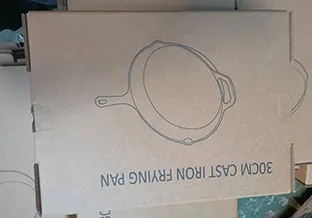
Comparing Cast Iron and Enameled Cast Iron for Cooking and Durability
Cast Iron vs. Enameled Cast Iron A Comprehensive Comparison
When it comes to cookware, cast iron and enameled cast iron are two popular materials that often come up in conversation. Each has its unique characteristics, advantages, and disadvantages, making them suitable for different cooking styles and preferences. This article will explore both types of cookware, comparing their benefits, drawbacks, maintenance requirements, and overall use in the kitchen.
What is Cast Iron?
Cast iron cookware has been a staple in kitchens for centuries, known for its exceptional heat retention and distribution. Made from molten iron poured into molds, cast iron pans, skillets, and Dutch ovens are durable, robust, and capable of withstanding high temperatures. They develop a natural non-stick surface when properly seasoned, which is achieved by applying oil and heating the cookware over time. This seasoning not only enhances the non-stick properties but also gives cast iron its characteristic black patina.
Advantages of Cast Iron
1. Heat Retention Cast iron excels at retaining heat, making it ideal for frying, searing, and baking. 2. Durability With proper care, cast iron cookware can last a lifetime and even be passed down through generations. 3. Versatility It can be used on the stovetop, in the oven, over a campfire, or even on an induction cooktop (provided it’s magnetic).
Disadvantages of Cast Iron
1. Weight Cast iron cookware tends to be heavy and can be cumbersome to handle, especially larger pieces. 2. Maintenance Regular seasoning is necessary to maintain the non-stick surface and prevent rusting. Washing with soap is typically discouraged. 3. Reactivity Cast iron can react with acidic foods (like tomatoes), which might alter the taste and damage the seasoning.
What is Enameled Cast Iron?
cast iron vs cast iron enamel

Enameled cast iron, on the other hand, is cast iron cookware that has been coated with a layer of enamel, providing a porcelain-like finish. This glass-like surface is non-reactive and adds an element of elegance and color to the cookware. Enameled cast iron is often manufactured in various vibrant hues, making it an attractive addition to any kitchen.
Advantages of Enameled Cast Iron
1. Easy Maintenance Enameled surfaces do not require seasoning and are generally easier to clean. They can usually be washed with soap and are often dishwasher safe. 2. Non-Reactive Unlike traditional cast iron, enameled varieties can safely cook acidic foods without any risk of flavor alteration. 3. Aesthetics The wide range of colors and designs makes enameled cast iron appealing for both cooking and serving.
Disadvantages of Enameled Cast Iron
1. Price Enameled cast iron cookware can be more expensive than its traditional counterpart, primarily due to the additional manufacturing process. 2. Chipping The enamel can chip or crack if not treated with care, which may expose the underlying cast iron to rust and damage. 3. Heat Distribution While it still retains heat well, enameled cast iron may not distribute heat quite as evenly as seasoned cast iron due to the enamel layer.
Which Should You Choose?
Choosing between cast iron and enameled cast iron ultimately depends on your cooking style, preferences, and maintenance willingness. If you seek durability, excellent heat retention, and enjoy the process of seasoning, traditional cast iron might be your best bet. However, if you prefer low-maintenance cookware that enhances the aesthetic of your kitchen and allows you to cook a variety of foods without worrying about reactivity, enameled cast iron is a worthy investment.
In conclusion, both cast iron and enameled cast iron cookware have their merits and drawbacks. Understanding these differences helps you make an informed decision based on your cooking habits and lifestyle. Whether you prefer the rustic charm of traditional cast iron or the colorful elegance of enameled cast iron, both options can enhance your culinary experience and yield delicious results for years to come.
-
Season Cast Iron Perfectly with GPT-4 Turbo TipsNewsAug.01,2025
-
High Quality Cast Iron Cookware - Baixiang County Zhongda MachineryNewsAug.01,2025
-
Premium Cast Iron Pan: Durable & Perfect HeatNewsAug.01,2025
-
High Quality Kitchen Durable Black Round Cast Iron Cookware Pancake Crepe Pan-Baixiang County Zhongda Machinery Manufacturing Co., Ltd.NewsAug.01,2025
-
Cast Iron Cookware - Baixiang County Zhongda Machinery | Nonstick, Heat ResistanceNewsAug.01,2025
-
High Quality Kitchen Durable Black Round Cast Iron Cookware - Baixiang County Zhongda Machinery | Non-Stick, Heat Retention, DurableNewsJul.31,2025


